THE CHEMICAL WATER TREATMENT FOR IMPROVING СOIL-TYPE DIRECT-FLOW STEAM GENERATORS
DOI:
https://doi.org/10.14529/power230110Keywords:
reverse osmosis installation, Na-cationite filter, electromagnetic effect, sediment formation, direct-flow steam generator, coaxial coilAbstract
Compared to boilers and drum steam generators, the uninterrupted operation of coil-type direct-flow steam generators requires improved feed water quality, which is difficult to achieve with conventional filters. The risk of deposits forming on the coil surface due to the poor quality of the water requires the best method of chemical water treatment, taking into account the operating conditions of the steam generator. The consideration of the most common methods of chemical water treatment and the modeling of the heat carrier flow through the coil pipes helps determine the chemical preparation of feed water. The article presents the results for water filters of various types, which are designed to ensure the normative chemical parameters of the coolant and the results of the modeling of the coaxial coil during the movement of chemically purified and source water. The optimal chemical purification of feed water is given.
Downloads
References
Приложение № 3 к Федеральным нормам и правилам в области промышленной безопасности «Пра-вила промышленной безопасности опасных производственных объектов, на которых используется обору-дование, работающее под избыточным давлением», утвержденным приказом Федеральной службы по экологическому, технологическому и атомному надзору № 116. М.: Изд-во стандартов, 2014. 254 с.
Typical scenarios of possible accidents in the stockroom of chemical water treatment of thermal power stations / T.G. Korotkova, S.A. Bushumov, S.Y. Ksandopulo, N.V. Solonnikova // Polythematic Online Scientific Journal of Kuban State Agrarian University. 2017. DOI: 10.21515/1990-4665-131-131
Полозов М.Б. Учебно-методическое пособие «Экология нефтегазодобывающего комплекса». Ижевск: Изд-во «Удмуртский университет», 2012. 174 с.
Дудкин М.М., Осинцев К.В., Кускарбекова С.И. Опытное исследование работы парового котла зме-евикового типа при эксплуатации на северном нефтяном месторождении // Вестник ЮУрГУ. Серия «Энер-гетика». 2019. Т. 19, № 4. С. 14–25. DOI: 10.14529/power190402
Опытное исследование аэро- и гидравлической систем прямоточного котла на лабораторном стен-де путем внедрения автоматического управления устройствами и сбора данных / К.В. Осинцев, С.И. Кус-карбекова, Н.В. Савостеенко, Н.М. Максимов // Вестник ЮУрГУ. Серия «Энергетика». 2022. Т. 22, № 2. С. 92–103. DOI: 10.14529/power220209
Лифшиц О.В. Справочник по водоподготовке котельных установок. 2-е изд., перераб. и доп. М.: Энергия, 1976. 288 с.
Черкасов, С.В. Обратный осмос. Теория и практика применения. Очистка воды // Мировые водные технологии. 2009. P. 1–38.
Особенности очистки воды от нефтепродуктов с использованием нефтяных сорбентов, фильтрую-щих материалов и активных углей / Е.В. Веприкова, Е.А. Терещенко, Н.В. Чесноков и др. // Журнал Сибирского федерального университета. Химия. 2010. Vol. 3 (3). С. 285–304.
Беликов, С.Е. Водоподготовка: Справочник / под ред. д.т.н., действительного члена Академии про-мышленной экологии С.Е. Беликова. М.: Аква-Терм, 2007. 240 с.
Физико-химические основы процессов очистки воды: учеб. пособие / А.Ф. Никифоров, А.С. Кутер-гин, И.Н. Липунов и др. Екатеринбург: Изд-во Уральского ун-та, 2016. 164 с.
Научный медицинский вестник Югры / под редакцией д.м.н. Ф.И. Петровского. Ханты-Мансийск: Информационно-издательский центр БУ «Ханты-Мансийская государственная медицинская академия», 2018. 86 с.
Передвижная парогенераторная установка серии Unisteam-М, Unisteam-МE на шасси грузового автомобиля: руководство по эксплуатации ПУ1-1600.100 РЭ. Миасс: ООО «Завод паровых установок Юнистим», 2018. 53 с.
Wesley E.W., Boero V.J., Houston F. Biological treatment of High TDS wastewater // Proceedings of the Water Environment Federation. 2001. Vol. 3. P. 66–73. DOI: 10.2175/193864701785019353
Долина Л.Ф. Новые методы и оборудование для обеззараживания сточных вод и природных вод. Днепропетровск: Континент, 2003. 218 с. ISBN 996-7086-29-2.
Flippin H., Cuomo L., Petersen L. Radically Increasing Treatment Facility Capacity of Low-Rate Anaer-obic Treatment System with Minimal Investment // Proceedings of the Water Environment Federation. 2013. Vol. 10. P. 5216–5222. DOI: 10.2175/193864713813692496
Flippin H., Boero V.J., Rhoades R. Enhanced activated sludge treatment of high strength bio-inhibitory industrial wastewater // Proceedings of the Water Environment Federation. 2004. Vol. 6. P. 598–607. DOI: 10.2175/193864704784106138
Automation and control of water treatment plant for defluoridation] / S. Dubey, M. Agarwal, A. Gupta et al. // International Journal of Advanced Technology and Engineering Exploration. 2016. Vol. 4 (26). P. 6–11. DOI: 10.19101/IJATEE.2017.426002









